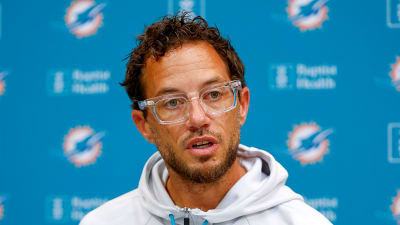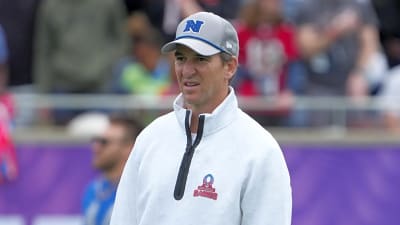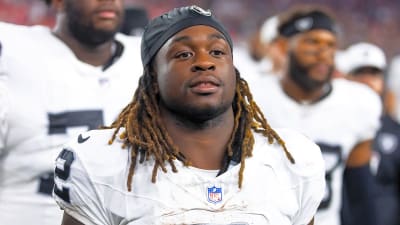- Home
- Quizzes
- My Quiz Activity
- Newsletters
- MY FAVORITES
- Add Sports/Teams
- SPORTS
-
NFL
- NFL Home
- Arizona Cardinals
- Atlanta Falcons
- Baltimore Ravens
- Buffalo Bills
- Carolina Panthers
- Chicago Bears
- Cincinnati Bengals
- Cleveland Browns
- Dallas Cowboys
- Denver Broncos
- Detroit Lions
- Green Bay Packers
- Houston Texans
- Indianapolis Colts
- Jacksonville Jaguars
- Kansas City Chiefs
- Las Vegas Raiders
- Los Angeles Chargers
- Los Angeles Rams
- Miami Dolphins
- Minnesota Vikings
- New England Patriots
- New Orleans Saints
- New York Jets
- New York Giants
- Philadelphia Eagles
- Pittsburgh Steelers
- San Francisco 49ers
- Seattle Seahawks
- Tampa Bay Buccaneers
- Tennessee Titans
- Washington Commanders
-
MLB
- MLB Home
- Athletics
- Arizona Diamondbacks
- Atlanta Braves
- Baltimore Orioles
- Boston Red Sox
- Chicago White Sox
- Chicago Cubs
- Cincinnati Reds
- Cleveland Guardians
- Colorado Rockies
- Detroit Tigers
- Houston Astros
- Kansas City Royals
- Los Angeles Angels
- Los Angeles Dodgers
- Miami Marlins
- Milwaukee Brewers
- Minnesota Twins
- New York Yankees
- New York Mets
- Philadelphia Phillies
- Pittsburgh Pirates
- San Diego Padres
- San Francisco Giants
- Seattle Mariners
- St. Louis Cardinals
- Tampa Bay Rays
- Texas Rangers
- Toronto Blue Jays
- Washington Nationals
-
NBA
- NBA Home
- Atlanta Hawks
- Boston Celtics
- Brooklyn Nets
- Charlotte Hornets
- Chicago Bulls
- Cleveland Cavaliers
- Dallas Mavericks
- Denver Nuggets
- Detroit Pistons
- Golden State Warriors
- Houston Rockets
- Indiana Pacers
- Los Angeles Clippers
- Los Angeles Lakers
- Memphis Grizzlies
- Miami Heat
- Milwaukee Bucks
- Minnesota Timberwolves
- New Orleans Pelicans
- New York Knicks
- Oklahoma City Thunder
- Orlando Magic
- Philadelphia 76ers
- Phoenix Suns
- Portland Trail Blazers
- Sacramento Kings
- San Antonio Spurs
- Toronto Raptors
- Utah Jazz
- Washington Wizards
-
NHL
- NHL Home
- Anaheim Ducks
- Boston Bruins
- Buffalo Sabres
- Calgary Flames
- Carolina Hurricanes
- Chicago Blackhawks
- Colorado Avalanche
- Columbus Blue Jackets
- Dallas Stars
- Detroit Red Wings
- Edmonton Oilers
- Florida Panthers
- Los Angeles Kings
- Minnesota Wild
- Montreal Canadiens
- Nashville Predators
- New Jersey Devils
- New York Islanders
- New York Rangers
- Ottawa Senators
- Philadelphia Flyers
- Pittsburgh Penguins
- San Jose Sharks
- Seattle Kraken
- St. Louis Blues
- Tampa Bay Lightning
- Toronto Maple Leafs
- Utah Mammoth
- Vancouver Canucks
- Vegas Golden Knights
- Washington Capitals
- Winnipeg Jets
- NCAAF
- NCAAM
- Olympics
- Boxing
- Entertainment
- Lifestyle
- Golf
- MMA
- Soccer
- Tennis
- Wrestling
- Sports Betting
- More Sports
- RESOURCES
- My Account
- YB on Facebook
- YB on Twitter
- YB on Flipboard
- Contact Us
- Privacy Policy
- Terms of Service

Never tell me the odds: One-in-a-million sports moments
Sometimes what happens on the field defies description, belief or, in some cases, the laws of physics. Let's sit back and take a look at some of the most truly astonishing, one-in-a-million plays in sports history.
Bill Belichick outsmarts himself, and the Dolphins pull a Miami Miracle
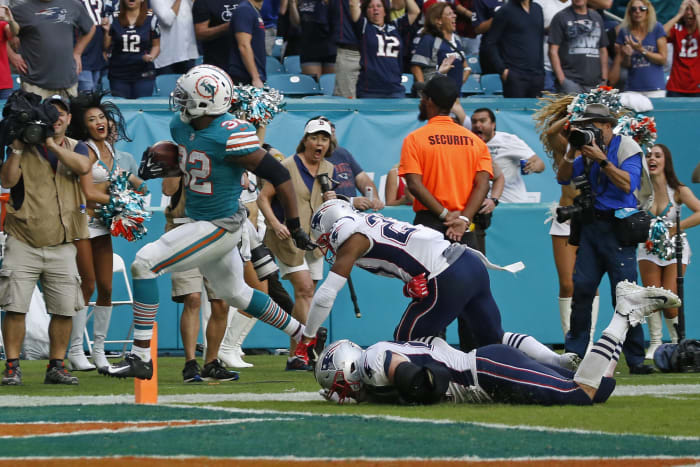
The Miami Dolphins had 69 yards to go, and seven seconds to do it, against the Patriots on Dec. 9, 2018. Rob Gronkowski was, inexplicably, New England's last line of defense on a play where there was zero chance of Ryan Tannehill throwing a ball 70 yards in the air to the end zone. Miami went for a hook-and-lateral play, and Kenyan Drake ended up with the ball. Gronkowski took a terrible angle on the play, allowing Drake to score the winning touchdown. It might not be the most improbable last-second touchdown ever, but it certainly was the most satisfying — if you dislike the Pats and Belichick.
Trent Tucker beats the buzzer, inspires a rule change
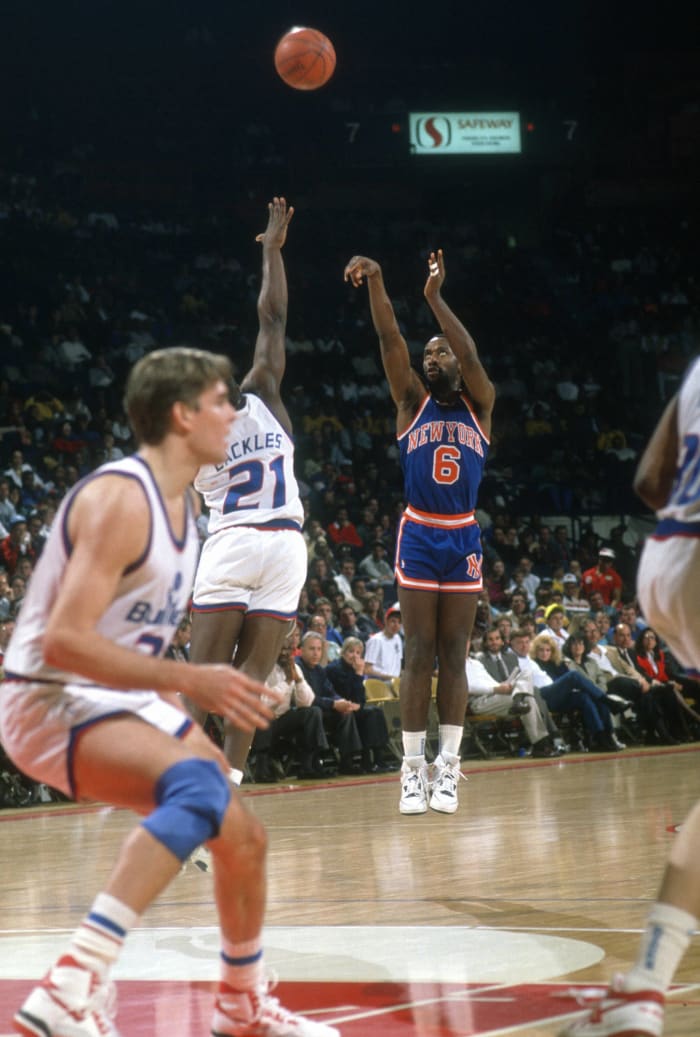
Most basketball fans are well aware of the rule that dictates that at least 0.3 seconds must be on the clock for a catch-and-shoot play to be technically possible. The reason for that rule? Its namesake, Trent Tucker. His Knicks beat the Bulls on Jan. 15, 1990, with a high-arcing three-point heave. There was just one problem: The sequence took place with just 0.1 seconds on the clock, and Tucker clearly had the ball for longer than that. Still, the shot itself is impressively unlikely, and the delirious reaction from the Madison Square Garden crowd makes it that much better.
Michael Block's Cinderella run gets an exclamation point

Part of the charm of the PGA Championship is that the 20 low scorers in the PGA Professional Championship get to tee it up with the touring pros. Occasionally one of these pros will hang around until the weekend, but none have ever seriously threatened to win the tournament. In the 2023 PGA at Oak Hill Country Club, Block, the head professional at Arroyo Trabuco Golf Club in Mission Viejo, California, started the final round tied for 8th. He shot a more than respectable 1-over 71 on the final day to finish tied for 15th, but all anyone will remember is what happened on the 15th hole, with playing partner Rory McIlroy looking on in gleeful disbelief.
Yadier Molina's sticky situation

An early-season Cubs-Cardinals game in 2017 turned from routine to strange when Cardinals reliever Brett Cecil struck out Matt Szczur on an 0-2 pitch that bounced in the dirt. When Molina looked for the ball to complete the play with a throw to first base, he couldn’t find it, because it was stuck to his chest protector. Szczur avoided making an out, and somehow, the Cardinals avoided any further investigation from the league. How? Your guess is as good as mine.
Corn Elder and Miami shock Duke

The lateral play on kickoffs rarely works. It’s a desperation tactic, and usually, a player tries to make a run for daylight, only to get cut down, or fumble to open space and have the kicking team fall on the ball. Despite the Duke Blue Devils playing defense perfectly for the better part of a minute, eventually they broke down, and Elder and Miami broke their hearts. Were all the laterals legal? Were all the blocks legal? Who can say, really? All that matters is that the Hurricanes won and gave college football fans an all-time memorable play in the process.
Michigan's punt fail gives Michigan State the win
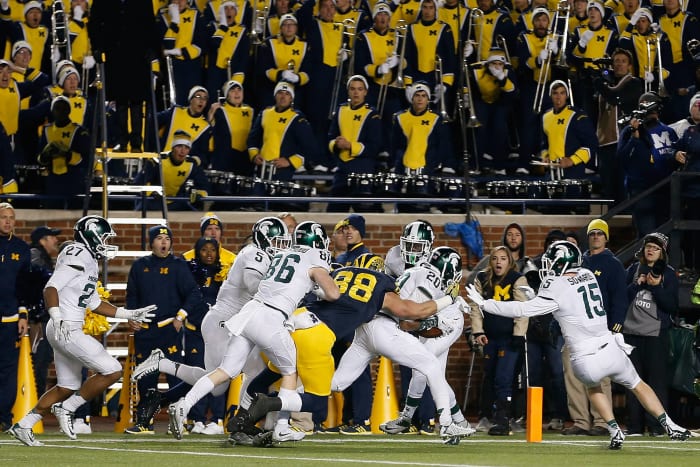
Seventh-ranked Michigan State looked destined for its first loss of the 2015 season when it trailed archrival Michigan, 23-21, with 10 seconds left and the Wolverines in punt formation at the Michigan State 47-yard line. All Michigan had to do was get the punt off, and the game was functionally over. They didn’t get the punt off, and the “Surrender Cobra" was born.
Rodgers connection makes Motown Miracle
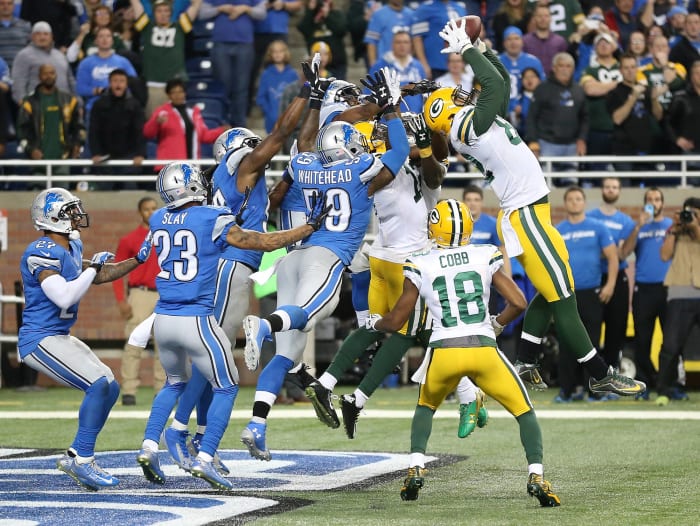
Aaron Rodgers is one of the most talented quarterbacks to ever take the field in the NFL. Richard Rodgers II is a run-of-the-mill tight end. Together, they combined for one of the most memorable plays in recent history, a 61-yard Hail Mary that came on an untimed down and gave Green Bay a 27-23 victory in 2015. The play is particularly noteworthy for Rodgers' throw — the ball traveled nearly 70 yards in the air and was high enough to nearly hit the rafters at Ford Field. For Lions fans of that era, it was yet another kick in the teeth.
Trevor Booker hits the ultimate "granny" shot

If you've been following along, dear reader, you already know about the Trent Tucker Rule, which stipulates that at least 0.3 seconds are required for a catch-and-shoot play. What to do, then, when there are only 0.2 seconds left on the clock? Follow Utah Jazz forward Booker’s lead. Most unlikely play in NBA history? I’d make a strong argument that it is.
Odell Beckham Jr. makes a catch for the ages

Beckham's later career hasn't quite reached the heights of his early years with the Giants, but when he was healthy and at his most explosive, there were few receivers in the league more naturally gifted, particularly when it comes to being sure-handed. His 2014 catch against the Dallas Cowboys on "Sunday Night Football" was the best catch of the year, the decade, the century and probably of all time. Even the notoriously joyless, crotchety Tom Coughlin couldn’t help but crack a wry smile at the absurdity of the play. Seriously, just watch this. It shouldn’t be possible, but for Beckham, it was.
The Kick-Six
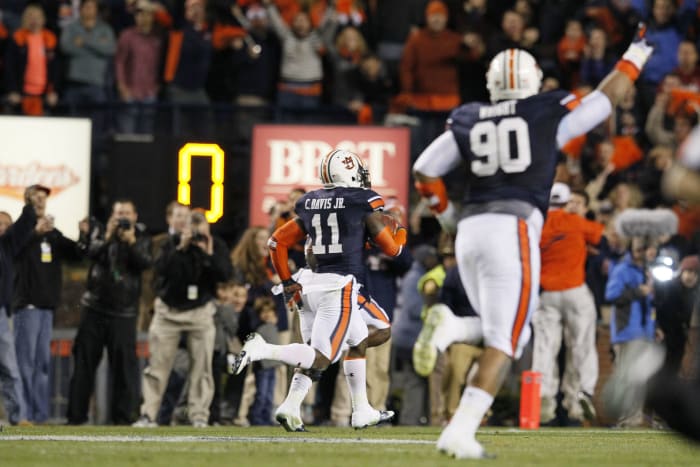
Missed field goals have been returned for touchdowns before. But a touchdown on a missed field goal return to win the 2013 Iron Bowl and leave Nick Saban with metaphorical egg on his face? That’s a true rarity and something worth celebrating — mainly by watching this clip over and over again. A fun fact: Saban argued to get a second put back on the clock – rightly, I might add – so that he Alabama could attempt the field goal in the first place. Whoops!
Michael Phelps casually hits a 159-footer

Like many athletes who have achieved fame and fortune in other sports, Phelps, an Olympic gold medalist swimmer, took up golfing as a hobby. If you’re a golfer, you know that even in bad rounds, there is one good shot that keeps you coming back. At the 2012 Alfred Dunhill Links Championship pro-am, Phelps was faced with a 159-foot putt on the par-4 sixth hole. What happened next made him a golfer for life.
DeSean Jackson beats the Giants in the cruelest possible fashion

All Giants punter Matt Dodge had to do at the end of the team’s 2010 battle with the Philadelphia Eagles was punt the football out of bounds, and he and New York would head to overtime in Week 15 of the 2010 season. Instead, he kicked a line drive right at Jackson, who promptly muffed his golden opportunity — but only for a split second. He proceeded to rip Giants’ fans hearts out and throw in a little extra salt for good measure.
Leif gets lucky

Leif Olson is probably a name you know only if you’re a hard-core golf fan, or if you’re familiar with his work at the 2009 Canadian Open. Olson was playing a par-3 when his tee shot spun back hard on the green and appeared to be going roughly 10 feet wide of the hole. At least it was until it struck another ball, changed course completely and ended up going in. The best part for Olson? He won a BMW convertible as a result. Not bad. Not bad at all.
Devin Harris sinks Sixers with circus shot

The New Jersey Nets looked headed for their sixth straight loss on Feb. 23, 2009, after Philadelphia's Andre Iguodala hit a free throw to give the Sixers a 96-95 lead with 1.8 seconds left. Harris got the ensuing inbounds pass and briefly lost control of the ball before regaining it and heaving a half-court shot that beat the buzzer by the slimmest of margins, and improbably went in. Only slow-motion replay truly does the shot justice.
Michael Ruffin's blunder is Morris Peterson's opportunity

Memo to all youth basketball players: If you’re protecting a lead in the final seconds of a game, and you steal a pass, either hang onto the ball until you get fouled or throw the ball very high and very far out of bounds. Actually, scratch that. Just hold the ball until you get fouled. Definitely don’t do what Washington’s Ruffin did against the Raptors in March of 2007. Oh, and the Wizards lost the game too.
Mike Blowers makes an eerily accurate prediction
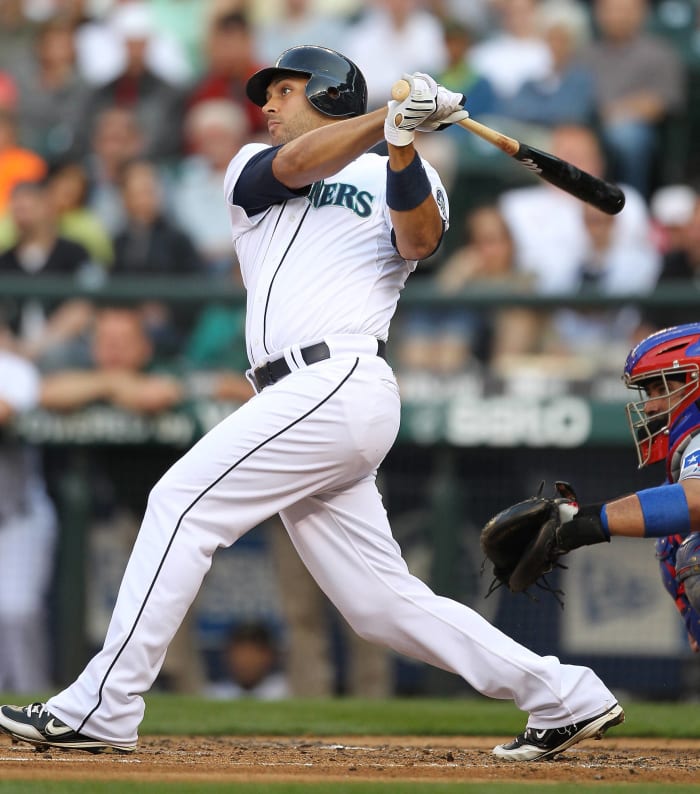
Part of being a sports media member is making predictions. Most of them are wrong. Occasionally, some are right, and infrequently, you’ll occasionally get the score of a game exactly right. Former Mariners infielder Blowers, working on the team’s pregame show before a 2009 game with the Blue Jays, went well beyond that when he made his “pick to click.” Blowers predicted that infielder Matt Tuiasosopo would hit his first career home run. OK, fair enough, right? He also predicted it would come in Tuiasosopo’s second at-bat, on a 3-1 fastball, and that the ball would be hit out to left-center field and reach the second deck. His prediction? It was pretty good.
Patrik Stefan forgets how to play hockey

Don’t know what to say about this one. Stefan, the top overall pick in 1999, deftly stole the puck and cruised toward an empty net. There was no one around him. He could have skated the puck all the way into the goal and ended his team’s January 2007 clash with the Edmonton Oilers. Instead, disaster struck. Give Stefan a million more chances and he’d never miss again, but once was all it took. For what it’s worth, the Stars won the game in a shootout, but who cares about that?
Vijay Singh skips one in at Augusta

Skipping golf balls over the pond at Augusta National’s 16th hole is a beloved practice round tradition at the Masters. But one year, Singh took things to a whole new level when he not only successfully skipped a ball over but also had it actually go in. Given the severe undulation of the green, it is one of the most remarkable shots, practice round or not, in golf history. Maybe the most remarkable, truth be told.
Blake Hoffarber saves his high school team from his back

Minnesota’s Hoffarber had a nice college career and even hit a pretty impressive buzzer-beater for the Golden Gophers. For sheer degree of difficulty, it had nothing on his most famous shot, from his high school days. Hoffarber’s high school trailed by two points with 2.5 seconds left and needed to go the length of the court for the tie. A full-court heave got knocked around, and in the chaos, Hoffarber fell to the ground and was laying on his back. He was in perfect shooting position, as it turned out. The shot sent the game to double overtime, and Hoffarber’s team eventually won the game — and the state title.
Alex Ovechkin's indescribable goal

The 2006 Washington Capitals were already comfortably ahead of the Phoenix Coyotes, then coached by Wayne Gretzky, when Ovechkin charged into the offensive zone on a rush, before getting tangled up and falling to his back and then sliding away from the goal and diagonally toward the boards. He somehow proceeded to score a goal, which somehow becomes both more incomprehensible and more impressive with each successive replay.
Tyrone Prothro makes the catch of a lifetime

You have to feel bad for Southern Mississippi cornerback Jasper Faulk. He had near-perfect coverage on Alabama’s Prothro in their 2005 matchup, and then Prothro went and did this. The catch is as audacious as it is spectacular, with Prothro catching the ball around Faulk’s back on a fourth-and-12 play near the end of the first half. The play was so great that it won the award for “Best Play" at the 2006 ESPY Awards.
Jordan Snipes hits perhaps the unlikeliest buzzer-beater ever

You've likely not heard of Guilford College, or Randolph-Macon, for that matter, but really, that doesn't matter. Here's all you need to know: In a Jan. 31, 2005, matchup, Randolph-Macon's Adam Krovic hit a free throw with 0.6 seconds left to give his team an 89-88 lead. Krovic was instructed by his coach to miss the second free throw. Sound strategy, right? I think you know where this is headed.
Randy Johnson obliterates a bird with a fastball
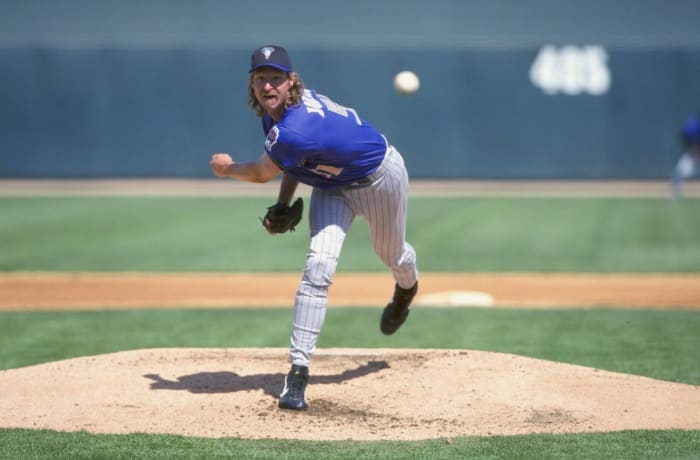
March 21, 2001, seemed like another sleepy day in the Arizona Diamondbacks’ spring training ritual. Johnson was on the mound, and an unassuming bird was flying through the ballpark. Then this happened. No further explanation seems necessary.
"He did what?!"

There are many great elements to this classic play from 2000. There’s the play itself, which is an example of incredible luck and incredible awareness by Antonio Freeman. There’s the fact that it happened at Lambeau Field, on "Monday Night Football," no less, and then there’s Al Michaels’ incredulous exclamation as the realization of what actually happened washes over him. All in all, a real treat and a game-winning play, to boot.
The Music City Miracle

You already know the setup. The Buffalo Bills had just gone ahead of the Tennessee Titans in their 1999 AFC wild-card clash and needed to survive only a kickoff and perhaps one play to punch their ticket to the divisional round. Things didn’t go as planned, to say the least. Was Frank Wycheck’s lateral legal? At this point, does it even matter? The Music City Miracle is an iconic, incredibly unlikely play in NFL history.
Fred Couples at The Players Championship

Ever dunked a ball in the water on a par-3 and wished you could just drop it in the cup on the next shot to get some revenge against the course? Couples had that happen at the most famous par-3 in golf: the island green 17th hole at TPC Sawgrass. During the first round of the 1999 Players Championship, Couples' first shot went in the water. He had to retee, and suffice to say, his second attempt went much, much better. Couples went on to finish fourth.
Jay Bell hits a million-dollar grand slam

Just watch this video, from start to finish. If the entire story doesn’t put a smile on your face, I don’t know what possibly could.
Fernando Tatis smacks two grand slams - in one inning

The title pretty much says it all for this one. Much like Johnny Vander Meer’s back-to-back no-hitters, Tatis’ feat likely won’t be matched and definitely won’t be topped. I mean, nothing is impossible, but hitting three grand slams in an inning might as well be. One other person involved also made history that will never be matched or topped: Chan Ho Park, who served up both home runs. Poor guy.
Turner Ward vs. the wall

Ward was tracking a long Mike Piazza fly ball during a May 1998 Dodgers-Pirates clash and made a nice leaping catch just before the wall. That in and of itself wasn’t anything special. Immediately after making the catch, Ward crashed into the wall, which proceeded to give way completely, with Ward falling through. He managed to get up, clearly injured and dazed, and shovel the ball back to the infield, wincing all the while. The mere sight of a wall giving way in such fashion is both painful and incredible.
The Flea Kicker

As a die-hard Nebraska fan in the 1990s — thanks, Tommie Frazier — I recall yelping with a mixture of shock and delight when this play happened. The 1997 Cornhuskers, undefeated and ranked No. 2 in the Associated Press poll and No. 1 in the Coaches’ poll, were on the ropes against Missouri, facing a third down from the 12-yard line with just seven seconds left. Quarterback Scott Frost tried to hit Shevin Wiggins at the goal line, but the ball caromed off him. As he fell to the ground, he kicked the ball up in the air and behind him, and receiver Matt Davison came diving in to catch the ball just before it hit the turf. Nebraska tied the game with the score, went on to win in overtime and ended up sharing the national championship with Michigan. The best part? Wiggins claimed the kick was intentional.
Popeye Jones tries to save ball, ends up with two points

In a late-'90s battle with the Los Angeles Lakers, Dallas' Jones found himself needing to both save a loose ball before it went out of bounds and somehow also shoot said ball, as the shot clock was inside three seconds. He managed to do both, blindly scooping the ball behind his back in the general direction of the hoop, just a split-second before his foot hit the ground out of bounds. The shot must be seen to be believed.
Isaiah Rider makes the unlikeliest three-pointer of his life
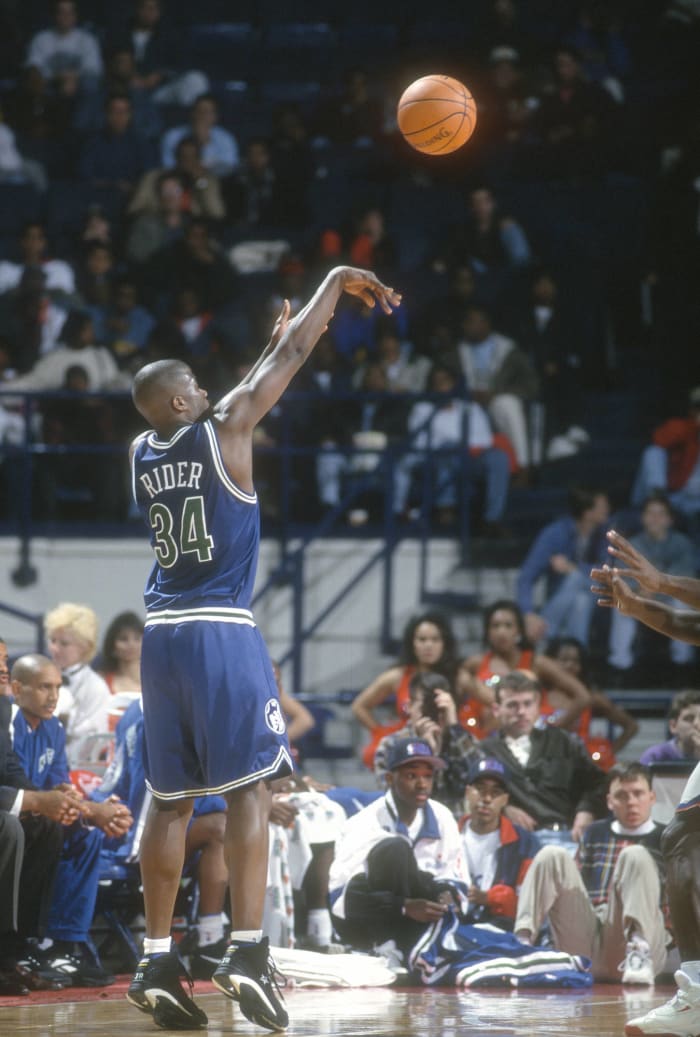
If Popeye Jones’ shot was unlikely, Rider’s heave was flat-out miraculous. The situation was much the same, with Rider hurtling out of bounds in pursuit of a loose ball roughly 35 feet from the hoop. He grabbed the ball and flung it across and behind him, never once looking at the hoop, only to have what was a “shot” in the loosest sense of the term go in. Rider was shocked, his Timberwolves teammates were shocked, and so were the Sacramento Kings and their fans — with good reason.
Chris Moore goes through the legs twice

Western Washington receiver Moore was going about his unassuming small-college career, when he went and made one of the most absurd catches you’ll ever see, in a 1992 game against the University of Puget Sound. (Throw away the records when those two schools do battle.) There’s no real way to describe the catch other than to say that Moore uses virtually every part of his body to secure the ball while careening out of bounds.
Kevin Mitchell makes a bare-handed catch - on a fly ball

Barehanded plays in baseball aren’t especially uncommon. There are often at least one or two per game, but they’re almost exclusively on slow rollers in the infield. Bare-handing a fly ball? It seems unthinkable, but that’s exactly what San Francisco Giants outfielder Mitchell did against the Reds in 1989. If you’ve ever tried to bare-hand a foul ball at a baseball game, you know how much it hurts, even if you succeed. Apparently that mattered little to Mitchell.
Paul O'Neill kicks one to the cut-off man
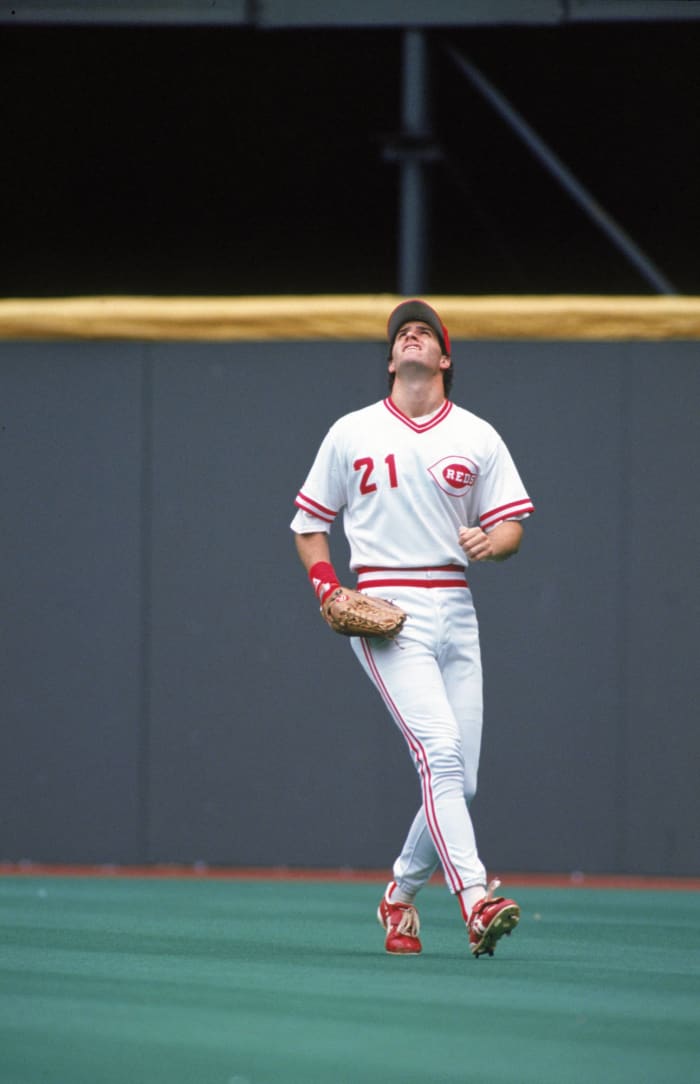
If you’re of a certain age, you probably remember O’Neill as the Yankees outfielder most likely to react with borderline rage every time he failed to get a hit. What you might not know is that he started his career with the Cincinnati Reds, and in July 1989, he had his temper work in his and the Reds’ favor — briefly. In the bottom of the 10th inning of a 2-2 game with the Phillies, O’Neill charged in on a Lenny Dykstra base hit that looked as if it would move base runner Steve Jeltz from second to third base. O’Neill bobbled the ball and, thinking the game was over, kicked it in frustration. The kick sent the ball directly to first base, which forced Jeltz to hold. Alas, two batters later, the Reds lost anyway, on a passed ball, of all things.
Isao Aoki gets his only win - from 128 yards away

Japan’s Aoki was trailing Jack Renner by one shot on the final hole of the 1983 Hawaiian Open. Renner had just made birdie on the hole to take his one-shot lead, and Aoki, playing in the group behind, was 128 yards away for his third shot on the par-5. He needed to get up and down to force a playoff and instead hit a perfect pitching wedge that took one bounce and went directly into the cup for a shocking victory. It was Aoki’s only PGA Tour victory and a shocking defeat for Renner, who couldn’t hide his disbelief when informed of Aoki’s feat.
The Play

How many different boxes does this play check? All of them? There’s a reason it gets mentioned whenever sports oddities are the topic. One school’s band came out on the field to celebrate victory prematurely. Its presence probably contributed to its team’s loss as much as anything. If that’s not a one-in-a-million moment, no such thing exists. One wonders: Does John Elway still think about this game?
U.S. Reed's half-court heave beats the defending champs
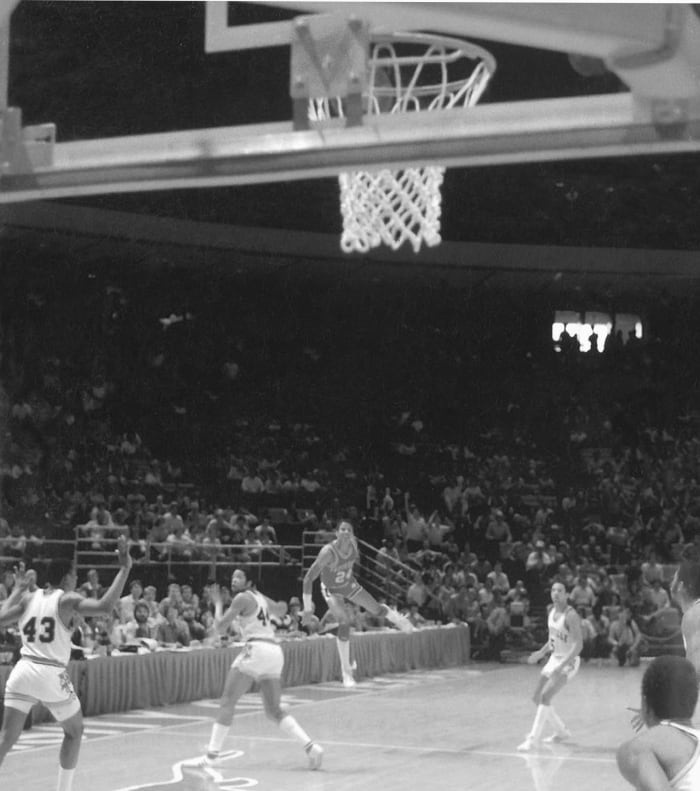
Reed and Arkansas needed a miracle, trailing defending national champion Louisville by a point with five seconds left in a 1981 NCAA Tournament clash. Reed moved the ball up court, hesitated around half court and then heaved one toward the hoop, barely beating the buzzer. It went in. If that doesn’t entice you, Marv Albert’s legitimately excellent call — while dealing with a very quick throw from Bryant Gumbel in the studio — is worth watching in its own right.
Ozzie Smith makes an incredible bare-handed adjustment

Most remember Smith for his time with the Cardinals, but his greatest defensive play in a career full of them came during his time with the Padres. Atlanta’s Jeff Burroughs hit a one-hop smash up the middle, and Smith had to range far to his left to have a play on the ball. When it actually hit the ground, it bounced sharply left and behind Smith, who somehow adjusted his body, bare-handed the ball, got up and threw Burroughs out. If it’s not the greatest infield play in baseball history, I don’t know what is.
The Immaculate Reception

It’s the most famous play in NFL history, and to this day, one that fans still argue over. Did Terry Bradshaw’s desperation pass touch Jack Tatum, thus making it legal? Or did it hit only receiver Frenchy Fuqua before ricocheting back to Franco Harris, which would have made the play illegal? Some wonder whether Harris even caught the ball before it hit the Three Rivers Stadium turf, though it seems clear that he did. Either way, when the dust settled, the 1972 Steelers had an improbable playoff win, and the Raiders a long plane ride home.
Jerry West hits a 60-footer to save the Lakers

Game 3 of the 1970 NBA Finals looked like it was over when the Knicks’ Dave DeBusschere hit a jump shot to give New York a 102-100 lead over the Los Angeles Lakers with three seconds left. West had other ideas. He took the inbounds pass, dribbled three times and then hit a 60-foot shot to tie the game and send it to overtime. The Knicks ended up winning the game, 111-108, and the series in seven games, but West’s shot, particularly given the stakes, is an all-time shocker.
Chris Mueller has been plying his trade as a sports radio host - or hot-take artist, if you prefer - since 2008. He's called 93. 7 The Fan in Pittsburgh home since its inception in 2010, and currently co-hosts the award-winning (no, really) PM Team from 2-6 p
More must-reads:
- All-Star's injury may force Heat into much-needed reset
- Eli Manning wouldn't help Giants QB Jaxson Dart with an unexpected request
- The '2024 NFL passing TD leaders' quiz
Breaking News
Trending News
Customize Your Newsletter
 +
+
Get the latest news and rumors, customized to your favorite sports and teams. Emailed daily. Always free!
PRIVACY POLICY EDITORIAL POLICY CONTACT US
ABOUT YARDBARKER TERMS OF SERVICE
Use of this website (including any and all parts and
components) constitutes your acceptance of these
Terms of Service and Privacy Policy.
This site is for entertainment purposes only.
There is no gambling offered on this site.
Gambling Problem? Call 1-800-Gambler.

